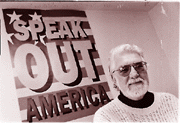Raking Muck
The godfather: Project Censored director Sonoma State University professor Carl Jensen is the recent recipient of the Society of Professional Journalists lifetime achievement award.
Changes carry SSU's Project Censored into its second generation
By Bruce Robinson
Twenty years ago, I thought it was the greatest thing since sliced bread, and I have not been disappointed," says Carl Jensen--the "father" of Project Censored--of his enduring brainchild. Even though the Sonoma State University communications professor is retiring at the end of the school year, he continues to have great expectations for the nationally renowned project, which ranks the year's most underreported news stories. "I don't think we've reached the peak at all."
The new Project Censored director is Peter Phillips, an SSU sociology professor whose thesis focused on Bohemian Grove, and who Jensen says has "two great talents which I didn't have: organization and fundraising." While the benefits of the latter are obvious, the additional organizational capacity is enabling Project Censored to extend its outreach deep into cyberspace. Its network of participating readers identified 700 stories that were reviewed in 1995; with expanded Internet contacts, that number is expected to swell to 2,000 this year, with as many as 500 net surfers contributing suggestions.
The Internet also gives Project Censored access to a broader range of sources, such as the top story on the latest list, which came from an Internet newsletter. The well-known co-author of that story, consumer advocate and presidential candidate Ralph Nader, will be the keynote speaker at the New York announcement of the Top 10 list for 1995, to be held in the same room at Columbia University in which the Pulitzer winners are announced.
While Nader is expected to draw some extra media attention, Jensen says that neither the Columbia Journalism Review nor the New York Times has ever mentioned Project Censored. "It's an embarrassment that they have ignored the nation's oldest ongoing news media research project," he grumbles.
This is exactly the sort of thing that Project Censored was created to combat, adds assistant director Mark Lowenthal, as the underlying intent of their list is to redefine censorship. "Censorship needs to be broadened to include not just overt censorship, but self-censorship as well as underreporting," he explains. "The stories that we cite from the [Washington] Post and the [New York] Times and other mainstream outlets are what we call hit-and-run coverage.
"Just because the story appears in one of these outlets does not mean that it reached the public; any story that is going to embed itself in the public consciousness requires repetition."
But repetition is also cropping up in the annual list of censored stories, says Judith Krug, director of the American Library Association's Office for Intellectual Freedom. Krug is a long-term member of the panel of media judges who choose the Top 10 from a list of 25 finalists that are selected by the Project Censored staff and SSU students. Other judges include UC Berkeley professor emeritus Ben Bagdikian and author Susan Faludi. Krug observes that while the subjects of those stories overall "have become more global," she is seeing less change in the list from year to year, "which means that despite Project Censored, a lot of these stories are not getting out. Which is a concern. A lot of the stories we're dealing with really need to get aired, and we're not getting through."
"Part of the problem," adds Berkeley writer and lecturer Michael Parenti, another Project Censored judge, "is that we become victims of the very censorship we're trying to confront. The project and our findings are routinely ignored by the mainstream multinational media."
There's a good reason for that, Jensen suggests. "These are the kinds of stories that tend to alienate the administration and corporate America, the power elite in our country," he says, "and the power elite is still fighting what we're trying to get out here."
At the same time, Lowenthal notes that the Top 10 Censored Stories list has been used "as a kind of tip sheet" by CNN and other news organizations. That is gratifying, to a degree, he says, "but sometimes too much attention gets placed on the stories, and the more important point is why there is a list, not what's on it."
With that noted, here is the newly released list of underplayed stories from 1995:
An additional 15 stories in the also-ran listing this year included such topics as the Gulf War Syndrome coverup, oil companies' more than $1.5 billion debt to the federal government, our lagging maternal health standards, the continuing dangers of dioxin, a rebirth of slavery in the Sudan, and the carcinogenic dangers of fiberglass.
This page was designed and created by the Boulevards team.

Janet Orsi
From the April 4-10, 1996 issue of the Sonoma Independent
Copyright © 1996 Metro Publishing and Virtual Valley, Inc.
